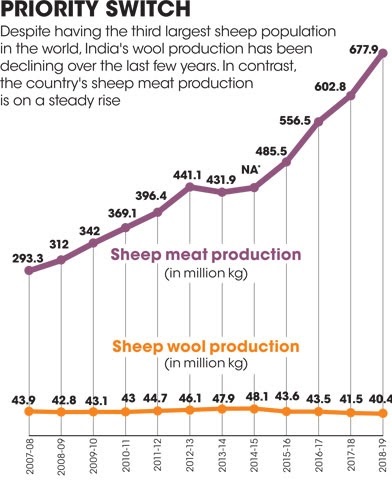India’s Wool Sector | 21 Aug 2021
Why in News
Amid the rising demand of import of wool, shepherds in Uttarakhand will get a batch of lambs through crossbreeding of sheep indigenous to the region with Australian Merino sheep by the end of the year.
- Australian Merino sheep are known to have the softest and finest wool used for apparels.
- The main trigger for import was the deteriorating quality and quantity of carpet and apparel grades wool, largely due to inbreeding.
Key Points
- About:
- India is the seventh-largest producer of wool and accounts for nearly 2 to 3% of total world production.
- India has the third largest sheep population in the world with over 64 million sheep. The annual wool production is in the range of 43-46 million kg.
- Due to the insufficient domestic production, India depends on imports for raw wool, particularly on Australia and New Zealand.
- This wool is then used to prepare products like carpets, yarn, fabrics and garments for the domestic market and for exporting, especially to the United States and Europe.
- Rajasthan is the largest wool producer and is known for its superior carpet grade Chokla and Magra wool.
- Carpet grade is rougher than apparel grade and accounts for 85% of India’s production.
- Apparel grade wool accounts for less than 5% of production and coarse grade fit for making rough blankets accounts for the rest.
- Significance:
- The wool textile industry provides employment to 2.7 million workers - 1.2 million in the organised sector, 1.2 million in sheep rearing and farming, and 0.3 million weavers in the carpet sector.
- Challenges:
- Fall in use of Indigenous Wool:
- In the 10 years till 2020, wool consumption by the country’s processing units increased by 50%, but the use of indigenous wool fell to almost 10% of the total current sales in Bikaner (Rajasthan).
- Decrease in Pastures:
- Pastures are diminishing across the country with the increase in plantations as well as urbanisation.
- In Rajasthan, grazing land fell from 1.7 million hectares (ha) in 2007-08 to 1.6 million ha in 2017-18, according to state agriculture department data.
- Pastures are diminishing across the country with the increase in plantations as well as urbanisation.
- Shift in Farmers focus:
- Farmers’ focus has shifted from wool to meat.
- Telangana promotes the meat-producing Nellore breed through a subsidised sheep distribution scheme and the breed now comprises 51% of the state’s sheep.
- Farmers’ focus has shifted from wool to meat.
- Others:
- Outdated and inadequate pre- and post-loom processing facilities.
- Ineffective role of state wool marketing organisations.
- Lack of a Minimum Support Price (MSP) system.
- No educational institute for wool technology.
- Fall in use of Indigenous Wool:
- Government Initiative:
- For the holistic growth of the wool sector, Ministry of Textiles, formulated an integrated programme i.e. Integrated Wool Development Programme (IWDP).
Way Forward
- Since most shepherds in the country rear sheep not by choice, but due to the lack of other options or because it is their traditional practice. So, there is a need to make this sector lucrative by raising awareness, improving access to pasture lands, facilitating marketing of wool, offering remunerative prices, and upgrading the supply chain for herders who are on the bottom rung of the ladder.

